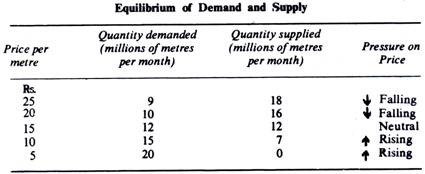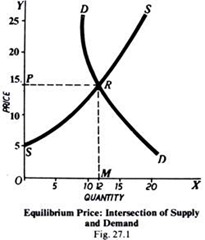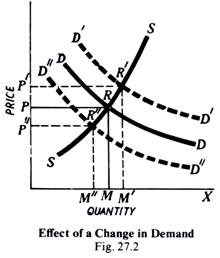We know that the behaviour of an entrepreneur or a firm under perfect competition assuming that a single firm or a producer cannot influence the price of his product by his own individual action.
A single firm, under perfect competition, then takes the market price as given and adjusts its output so as to obtain maximum profits.
Now the interaction between these two forces of demand and supply determines price in the market.
It is not the demand and supply of the single buyer and firm respectively that determine price but it is the demand of all the buyers taken together and the supply of all the firms taken together that determine the price by their interaction.
ADVERTISEMENTS:
Equilibrium Price: Interaction of Demand and Supply:
Price, under conditions of perfect competition is determined by the interaction of demand and supply. Before Marshall, there was a dispute among economists as to whether the force of demand (i.e., marginal utility) or the force of supply (i.e., cost of production) is more important in determining price. Marshall gave equal importance to both demand (or marginal utility) and supply (or cost of production) in the determination of value or price.
His famous analogy of a pair of scissors is worth quoting:
“We might as reasonably dispute whether it is the upper or the under blade of a pair of scissors that cuts a piece of paper, as whether value is governed by utility or cost of production. It is true that when one blade is held still and the cutting is effected by moving the other, we may say with careless brevity that the cutting is done by the second, but the statement is not strictly accurate and is to be excused only so long as it claims to be merely a popular and not a strictly scientific account of what happens.”
ADVERTISEMENTS:
Thus, neither the upper blade nor the lower one taken individually can do the work of cutting; both have their importance in the process of cutting. The lower blade may be kept stationary and only the upper one may be moved, yet both are indispensable for the process of cutting.
“The only really accurate answer to the question whether it is supply or demand which determines price is that it is both. At times it will seem that one is more important than the other, for one will be active and the other passive. For example, if demand remains constant but supply conditions vary, it is demand which is passive and supply active. But neither of the two is more or less important than the other in determining price.”
The demand of all consumers and the supply of all firms together determine the prices which are then taken as given by each of them. Prices are determined in the market where consumers and sellers meet and exchange takes place among them. A demand curve normally slopes downwards. In other words, it means that, other things remaining equal, larger quantity of a commodity will be demanded at a lower price than at a higher price.
Similarly, we have concluded, that the supply curve of the commodity normally slopes upwards. In other words, the producers will offer to sell a larger quantity of the product at a higher price than at a lower one. Thus quantity demanded and quantities supplied vary with price. The price which tends to settle down or comes to stay in the market is one at which quantity demanded is equal to quantity supplied. Only at that price will all buyers’ and sellers’ wishes be satisfied.
ADVERTISEMENTS:
The price at which demand and supply are equal is known as an equilibrium price, since at this price the forces of demand and supply are balanced, or are in equilibrium. The quantity bought and sold (or the amount supplied or demanded) at this equilibrium price is known as equilibrium amount.
If the equality between quantity demanded and supplied does not hold for some price, buyers’ and sellers’ desires are divergent either the amount demanded by buyers is more than that offered by sellers, or the amount offered for supply by sellers is greater than the amount demanded by buyers. In either case, the price will change so as to bring about equality between quantity demanded and quantity supplied.
Diagrammatic Representation:
An example in terms of both schedules and curves will make the whole thing clear. The table given below gives the demand and supply schedules relating to a variety of cotton cloth, and in Fig. 27.1 DD is the demand curve and SS is the supply curve. A glance at the table and the figure will show how the price is determined by demand and supply.
It will be seen that, when price is Rs. 15 per meter, 12 million meters are supplied and 12 million meters are demanded; the quantity demanded is equal to the quantity supplied. Rs. 15 per meter, therefore, is the equilibrium price. Price is in equilibrium at Rs. 15 or price of Rs. 15 will persist in the market, because at this level there is no tendency for it to rise or fall. Of course this equilibrium price may not be reached at once. There may have to be an initial period of trial and error or oscillations around this equilibrium level before price finally settles down and supply balances demand.
If, for example, the price is Rs. 25 (i.e., above the equilibrium level), the quantity offered in supply (18 million metres) by sellers will be greater than the quantity demanded (9 million metres), and there will be a tendency for the price to fall. At the price of Rs. 25, some of the sellers will be unable to sell all the quantity they want to sell, and will, therefore, cut down the price in order to attract customers.
As the price falls, the quantity demanded will extend and the quantity supplied will contract in the way shown in the table until, at the price of Rs. 15 per metre, supply balances demand and all the quantity of the product, which all sellers are willing to sell, will be purchased by the buyers.
ADVERTISEMENTS:
Similarly, if the price is Rs. 10 per metre, i.e., below the equilibrium price, the amount of the cotton cloth demanded (15 million metres) by the buyers will exceed the amount offered for supply (7 million metres); therefore, the price of cotton cloth will tend to rise.
Since at Rs. 10, the quantity demanded exceeds the quantity supplied, the buyers who are willing to buy at this price find that the quantity offered is not sufficient to satisfy their wants, i.e., the sellers are not I willing to supply as large a quantity as the buyers demand.
Some of the consumers, who have not been able to satisfy their demand, will be induced to bid the price up in the hope of getting more supplies. This action of unsatisfied buyers will force up the price in the market up to the equilibrium level.
Thus Rs. 15 is the equilibrium price and 12 million meters is the ‘equilibrium amount, because only at this price of Rs. 15 per meter will there be no tendency for the price to rise or fall. Only at this price, there will be no unsatisfied buyers or sellers, who are prepared to let price alter to satisfy their desires.
ADVERTISEMENTS:
Conclusion:
It follows that the equilibrium between demand and supply, or what is often called market equilibrium, determines the price in the market. Price comes to settle in the market at the level where demand and supply curves intersect each other.
Effect of Change in Demand and Supply:
The equilibrium price will change if either the demand or the supply curve changes due to changes in demand or supply conditions. Given the supply curve, an increase in demand (i.e., shift of the demand curve to the right) will raise the price, and a decrease in demand (i.e., shift of the demand curve to the left) will lower the price.
ADVERTISEMENTS:
On the contrary, an increase in supply (i.e., shift of the supply curve to the right), demand curve remaining the same, will lower the price, and a decrease in supply (i.e., shift in the supply curve to the left) will raise the price. The change in equilibrium price, as a result of change in demand or supply curves, is shown in the following diagrams.
In Fig. 27.2 SS is the supply curve and DD is the-original demand curve. If now there is an increase in demand from DD to D’D’ the supply curve remaining the same, equilibrium price will rise to OP’, at which the new demand curve D’D’ intersects the supply curve SS.
As a result of the increase in demand, equilibrium amount demanded and supplied will also rise to OM’. On the contrary, if the demand decreases from DD to D”D”, the equilibrium price will fall to OP”, and the equilibrium amount will contract from OM to OM”.
On the other hand, in Fig. 27.3 demand curve DD remains the same, and it is the supply curve which changes. To begin with, SS is the supply curve which intersects the demand curve DD at the price OP. If now the supply increases from SS to S’S’, the equilibrium price will fall to OP’, and the equilibrium amount will extend to OM’. If supply decreases from SS to S”S”, the equilibrium price will rise to OP”, and the equilibrium amount will fall to OM Thus, we see that changes either in demand or in supply will change the equilibrium price.
ADVERTISEMENTS:
From the above analysis, it is clear that price is determined by the interaction of demand and supply. But it should be remembered that demand and supply are ‘themselves governed by a host of other factors. ‘Supply and Demand’ is only a superficial formula. Professor Samuelson rightly remarks: “Supply and demand are not ultimate explanations of price. They are simply useful catch-all categories for analyzing and describing the multitude of forces, causes and factors impinging on price. Rather than being final answers, supply and demand simply represent initial questions. Our work is not over but just begun.”
For example, the cost of production is the main determinant of supply curve. A change in the cost of production will change the supply curve and will thus change the equilibrium price. Similarly, the market demand for a commodity may change because the incomes of the consumers have changed or the total numbers of consumers have changed because of the change in the size of population.
Thus, we see that factors like cost of production, income of the consumer, and the size of the population take part in determining price but all of them work either through supply or through demand.



